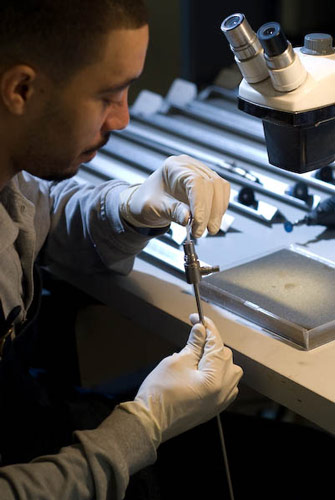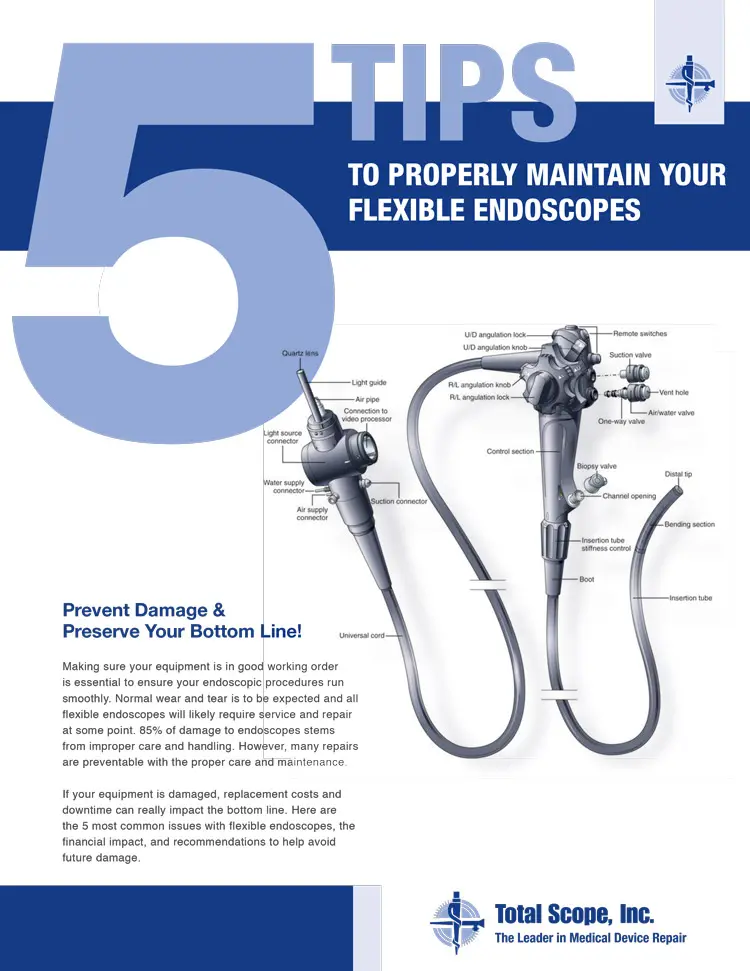 Tracking the repair history of each of your scopes may not sound like much fun, but it can be very worthwhile. It’s all too easy in the rush of the suite to simply use a scope, clean a scope, use it again, and send it out if it breaks. Logging in the repairs done, as well as periodically reviewing this repair chart, can tell you things about your scope, and perhaps your suite.
Tracking the repair history of each of your scopes may not sound like much fun, but it can be very worthwhile. It’s all too easy in the rush of the suite to simply use a scope, clean a scope, use it again, and send it out if it breaks. Logging in the repairs done, as well as periodically reviewing this repair chart, can tell you things about your scope, and perhaps your suite.
Getting Started With Tracking Your Scopes
First, consider creating a single tracking page for each scope. On it, write up the scope’s make, model, serial number and the date it was placed in service. As needed, enter the repairs it undergoes as well as the cost of each repair and who performed it.
Over time, take a look at the entries. Do you see any patterns? If there is a recurring repair, you should ask yourself some questions:
- Does this scope have a bigger problem that’s not being addressed?
- Is this repeated mistake being caused by staff mis-handling the equipment?
- Do you need to train newer staff members on the proper care and handling of your
scopes? - Does a doctor need more information about how best to maintain scope performance to
his satisfaction? - Is your scope repair company doing the repair properly?
- Is your scope simply getting old and should be considered for retirement?
Make sure you look at repairs across all scopes, not just the repairs for a single scope. Patterns of use, or mis-use, can emerge.
Remember to take a look at the age of your scopes. If they are getting on in years, you may need to consider new equipment. Older equipment can be more prone to breaking down. Replacing the scope(s) could pay off in reduced repair costs and better suite up-time performance over the long haul.
Identifying Issues
As you look for repair patterns, see if you have an inordinately high problem with fluid invasion. Fluid invasion is one of the most costly, time-consuming and damaging of all service issues. It’s also one of the most preventable. If you’re having recurrent problems with fluid invasion, review proper leak-testing procedures with your staff as well as the standard handling and cleaning procedures. There are some little known techniques to leak-testing and things to look for (like the age of your water caps – they’re supposed to be replaced every 18 months, but few people know this) that can help. Ask your scope repair company or your manufacturer for help in these areas.
Another thing to monitor is the frequency of use of a scope. The more frequently a scope is used (and also cleaned), the faster it will deteriorate and become liable to breaking.
Also, be aware that if you practice in a teaching facility, you may be more prone to break-downs. The inexperience of the handlers can lead to a higher frequency of repair.
Tracking Your Scope Repair Company
Two things to track as far as the performance of your scope repair company are price for each repair and turnaround time. Minor repairs should be able to be fixed in a day or two. And 90% of your repairs should be categorized as minor. Only 10% of your repairs should be major. And though there are some exceptions, most major repairs should be able to be done in a week or so.
If your repair service is taking longer, or you find that an excessive percentage of repairs are “major” and/or require a complete overhaul, you may want to get a second opinion about your overall scope repair situation and what other vendor options may exist.
You may also want to ask your repair facility how much of the work they’re doing themselves vs. sending it to a third party. Is this third-party outsourcing what’s holding up your turnaround time?
Evaluating Your Repair Services
Remember, these are your scopes. They belong in your suite, not the repair companies’ labs. If they can’t fix it promptly, they need to tell you why and give you your alternatives.
Also, track your repair costs. Don’t be afraid to go to other scope repair vendors and ask what they’d charge for similar repairs. Many will provide you with a price list. Some even have a price list, or a partial one, posted on their web sites.
Compare prices across various vendors. Find out if the fees you’re paying are competitive. You may decide that you need to discuss fees with your current repair vendor, or perhaps you’ll decide to seek another repair source. At some point, you may determine that the cost of repairing your scope repeatedly (and the associated downtime) is more than the cost of buying a new scope. This can apply especially to older scopes.
Keep an eye on the cleaning method used, too. Some methods are harder on equipment than others. And if you’re switching from one method to another, it may create problems that were previously not apparent. Again, your repair companies and manufacturers should be able to help you in these matters. Click here to learn the 7-step cleaning method that we favor.
To re-cap, watch these repair factors and analyze appropriately:
- age of scope
- type of repair
- frequency of repair
- cost of repair
- turnaround time for repair
- cleaning method
- frequency of use of scope
Contact us for Help With Scope Maintenance
Life in the suite is busy, but investing some time and energy in these reports and analysis can pay off in better scope maintenance, less downtime, lower repair costs, better budget adherence, better training for staff, and knowing when it might be time for new equipment. And remember, you can always ask your scope repair company or manufacturer for help.
If you’d like more information about endoscope maintenance and repair, you’re welcome to contact the experts at Total Scope, Inc. Call us at 800-471-2255.
 FREE SHIPPING Anywhere in the Country for Repairs
FREE SHIPPING Anywhere in the Country for Repairs